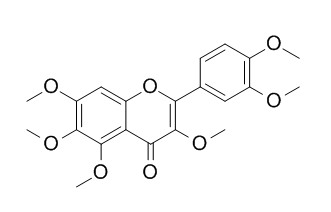Hexamethylquercetagetin
Reference standards.
Inquire / Order:
manager@chemfaces.com
Technical Inquiries:
service@chemfaces.com
Tel:
+86-27-84237783
Fax:
+86-27-84254680
Address:
1 Building, No. 83, CheCheng Rd., Wuhan Economic and Technological Development Zone, Wuhan, Hubei 430056, PRC
Providing storage is as stated on the product vial and the vial is kept tightly sealed, the product can be stored for up to
24 months(2-8C).
Wherever possible, you should prepare and use solutions on the same day. However, if you need to make up stock solutions in advance, we recommend that you store the solution as aliquots in tightly sealed vials at -20C. Generally, these will be useable for up to two weeks. Before use, and prior to opening the vial we recommend that you allow your product to equilibrate to room temperature for at least 1 hour.
Need more advice on solubility, usage and handling? Please email to: service@chemfaces.com
The packaging of the product may have turned upside down during transportation, resulting in the natural compounds adhering to the neck or cap of the vial. take the vial out of its packaging and gently shake to let the compounds fall to the bottom of the vial. for liquid products, centrifuge at 200-500 RPM to gather the liquid at the bottom of the vial. try to avoid loss or contamination during handling.
Plant J.2021, 107(6):1711-1723.
Nat Chem Biol.2018, 14(8):760-763
The Japan Society for Analytical Chemistry2017, 613-617
Int J Mol Sci.2021, 22(21):11836.
Arabian Journal of Chemistry2024, 17(3):105648
Industrial Crops and Products2017, 95:286-295
Nutrients.2018, 10(12)
Nutrients.2020, 12(5):1242.
bioRxiv2021, 462065.
EXCLI J.2023, 22:482-498.
Related and Featured Products
Biomed Chromatogr. 2007 Jan;21(1):48-54.
Determination of polymethoxylated flavones in peels of selected Jamaican and Mexican citrus (Citrus spp.) cultivars by high-performance liquid chromatography.[Pubmed:
17080505 ]
The concentrations of the polymethoxylated flavones (PMFs) in peels of selected citrus cultivars grown in Jamaica and Mexico were determined. The PMFs were extracted from sun-dried citrus peels with reagent-grade methanol.
METHODS AND RESULTS:
Analyses were carried out by reverse-phase HPLC and UV detection. The column used was a C(18) 5 microm (150 x 4.6 mm) Discovery column. Elution was in the gradient mode, using a ternary mobile phase. The results showed that all the citrus cultivars used contained at least three of the six major PMFs quantified. Ortanique peel contained the highest quantity of PMFs (34,393 +/- 272 ppm), followed by tangerine (28,389 +/- 343 ppm) and Mexican sweet orange (sample 1; 21,627 +/- 494 ppm). The major PMFs, i.e. sinensetin, nobiletin, tangeretin, heptamethoxyflavone, tetramethylscutellarein and hexamethyl-o-quercetagetin(Hexamethylquercetagetin ), present in the peels of 20 citrus cultivars, was quantified.
CONCLUSIONS:
The results were compared with those of Florida citrus peels. A large amount of citrus peels and byproducts are produced in the Caribbean which could provide a cheap and convenient source of PMFs.



